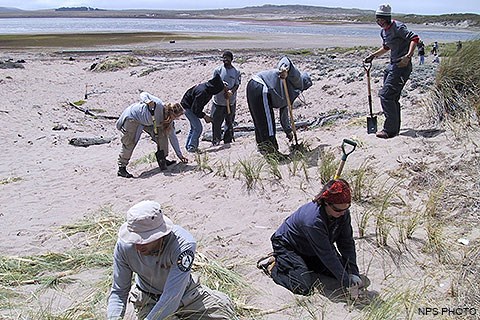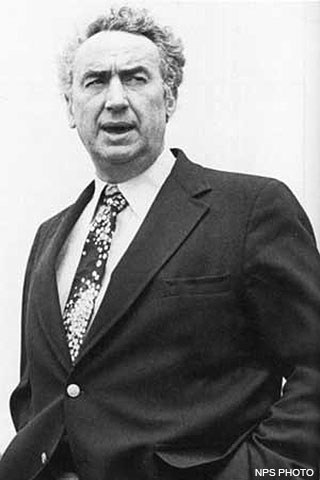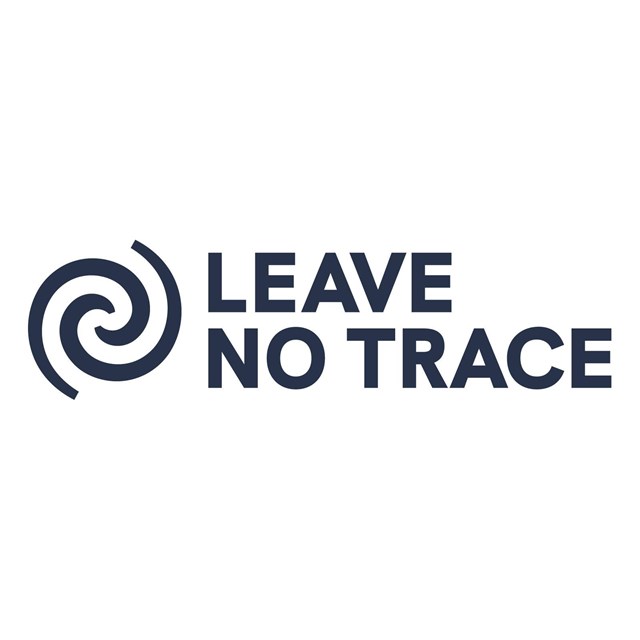
Point Reyes National Seashore is home to the Phillip Burton Wilderness, where visitors can explore over 30,000 acres of forested ridges, coastal grasslands, sand dunes, and rugged shoreline. Visitors can enjoy a quiet evening on a secluded beach watching the sun set over the Pacific Ocean, or experience the power of a winter storm or the spring winds generating massive waves on the Point Reyes Beach. Over 100 miles of trails wind their way through the Phillip Burton Wilderness, inviting visitors to leave the stress of today's mechanical/electronic world behind for an hour or a day. Wildlife also thrives throughout the park's Wilderness. Visitors may observe tule elk on Tomales Point, harbor seals, waterfowl, and shorebirds in the Estero de Limantour, and a multitude of marine invertebrates in tidepools. These are just a few of the many benefits of wilderness. All of this within a couple-hours travel time for over eight million San Francisco Bay area residents. The land that is now Point Reyes National Seashore and the Phillip Burton Wilderness are the traditional homelands of Coast Miwok, who had lived throughout what is now Marin County and southern Sonoma County since time immemorial. In the early 1800s, Franciscan missionaries introduced feral cattle to the area. Secularization of the missions following Mexican independence from Spain led to land grant subdivision and the expansion of cattle ranching on the peninsula. In the late 1800s, over 30 ranches were established across the peninsula, many of which still operate today outside of the Phillip Burton Wilderness. In 1962, Congress authorized the National Park Service to purchase the ranch lands in order to create Point Reyes National Seashore, and later passed legislation in 1976 to designate some of those lands as wilderness. Point Reyes National Seashore's Park Map (8,511 KB PDF) indicates which sections of the park are protected as the Phillip Burton Wilderness. As of 2024, the Philip Burton Wilderness encompassed 27,315 acres of designated wilderness and 5,415 acres of potential wilderness. (Acreage cited is based on "current" acreages informed by GIS mapping technology, which may differ from older sources.) 
Wilderness areas are public lands. This means wilderness belongs to everyone. Wilderness areas also provide intact habitat for wildlife, clean drinking water for cities, recreational opportunities for outdoor enthusiasts, sources of inspiration for artists, and much more. Wilderness areas also provide a place for reflection and introspection. What does wilderness means to you? Is it a place of inspiration? Adventure? Or maybe even a place you have not visited but still appreciate? We can all be stewards of these special places and ensure their protection well into the future. Visit Wilderness Volunteers' website to learn more about how you can be a wilderness steward. 
President Lyndon B. Johnson signed the Wilderness Act on September 3, 1964, to provide the highest level of protection for some of America's iconic, wild landscapes. The US Congress passed legislation (Public Law 94-544) in 1976 that created the Point Reyes Wilderness. The Congress passed Public Law 99-68 in 1985, which declared: In recognition of Congressman Phillip Burton's dedication to the protection of the Nation's outstanding natural, scenic, and cultural resources and his leadership in establishing units of the National Park System and preserving their integrity against threats to those resources and specifically his tireless efforts which led to the enactment of the California Wilderness Act of 1984, the designated wilderness area of Point Reyes National Seashore, California as established pursuant to law, shall henceforth be known as the "Phillip Burton Wilderness". Phillip Burton served in the US House of Representatives from 1964 until his death on April 10, 1983. Learn more about Congressman Phillip Burton: 1926-1983. Learn More about the Phillip Burton Wilderness
MultimediaVideos from NPSWilderness:
Visit our keyboard shortcuts docs for details
The Wilderness Act of 1964 established the National Wilderness Preservation System, a national network of more than 800 federally-designated wilderness areas. These wilderness areas are managed by the National Park Service, Bureau of Land Management, US Fish and Wildlife Service, and US Forest Service.
Visit our keyboard shortcuts docs for details
Point Reyes National Seashore, located just an hour north of San Francisco, is home to the Phillip Burton Wilderness. This wilderness area protects more than 26,000 acres of important habitat and serves as a place of inspiration for people near and far.
Visit our keyboard shortcuts docs for details
See the natural rhythms of Point Reyes National Seashore's Phillip Burton Wilderness. Point Reyes is the windiest place on the Pacific Coast, one of the foggiest places in North America, and home to thirty-eight threatened or endangered species.
Visit our keyboard shortcuts docs for details
Join local photographers Kathleen Goodwin and Richard Blair on Kehoe Beach in the Phillip Burton Wilderness. Point Reyes National Seashore includes 80 miles of coastline, most of which is designated wilderness. |
Last updated: December 27, 2024






